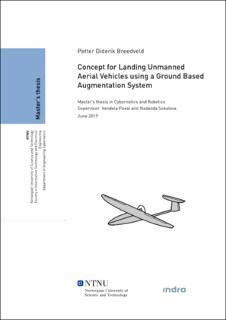| dc.contributor.advisor | Paxal, Vendela | |
| dc.contributor.advisor | Sokolova, Nadezda | |
| dc.contributor.author | Breedveld, Petter Diderik | |
| dc.date.accessioned | 2019-10-31T15:15:33Z | |
| dc.date.issued | 2019 | |
| dc.identifier | no.ntnu:inspera:35771502:17013765 | |
| dc.identifier.uri | http://hdl.handle.net/11250/2625776 | |
| dc.description.abstract | Denne oppgaven, Concept for Landing Unmanned Aerial Vehicles using a Ground Based Augmentation System, fokuserer på mulighetene for autonom landing av kommersielle ubemannede luftfartøy (UAV) ved å integrere det eksisterende Ground Based Augmentation Systemet (GBAS) med UAV avionikk.
Ulike måter å integrere GBAS og avionikk signaler ble utviklet, og resulterte i et konsept som ble brukt til å designe den nødvendig maskin- og programvaren for en prototype. Systemet ble test-montert i en eksisterende UAV ved Andøya Space Center (ASC).
Studien resulterte i et system som enkelt kunne integreres med eksisterende avionikk, uten signifikant modifikasjon av eksisterende UAV-maskinvare, og som bare krever minimal modifikasjon av flyet.
Et program med åpen kildekode ble modifisert for mottak av GBAS-signaler. Datainnholdet i kringkastingen blir gjort tilgjengelig for å korrigere GPS-pseudorange målingene.
GPS-pseudorangene blir utjevnet ved hjelp av bærebølgen, slik at GBAS korreksjonene kan brukes. Dette resulterer i forbedret posisjonsberegning. Konsekvensene av hopp i pseudorange målingen ble vurdert, og metoder ble foreslått for å minimere effekten.
To forskjellige maskinvare prototyper ble utviklet basert på ettkortsdatamaskiner og testet. Bare det Raspberry Pi baserte systemet klarte å håndtere radiodekodingen og kommunisere med UAV-avionikken ved ASC.
GBAS-implementering vil forbedre autonome landingsegenskaper for UAV, uavhengig av flyplass og værforhold. Dette vil utvide mulighetene for ubemannede operasjoner i fremtiden. | |
| dc.description.abstract | This thesis, Concept for Landing Unmanned Aerial Vehicles using a Ground Based Augmentation System, focuses on the possibilities of autonomous landing of commercial Unmanned Aerial Vehicles (UAVs) by integrating the existing Ground Based Augmentation System (GBAS) with UAV avionics.
Potential ways of integrating GBAS and avionics signals were developed and resulted in a concept which was used to design the neccesary hardware and software for a prototype application. The system was test fitted in an existing UAV system at Andøya Space Center (ASC).
The study resulted in a system that could be integrated neatly with existing avionics, without significant modification of the existing UAV hardware and requiring only minimal modification of the airframe.
Opensource software was succesfully modified for the reception of GBAS signals. The contained data in the broadcast are made available for correcting the GPS pseudoranges.
GPS pseudoranges are smoothed using the carrier phase, so that corrections can be applied. This results in augmented position data. The consequences of pseudrange jumps were assessed, and mitigation methods were proposed.
Two different hardware prototypes were developed based on single-board computers and tested. Only the Raspberry Pi based system was able to handle the radio samples and communicate with the UAV avionics at ASC.
GBAS implementation will improve autonomous landing capabilities of UAVs, independent of airfield and weather conditions. This will extend the capabilities of unmanned operations in the future. | |
| dc.language | eng | |
| dc.publisher | NTNU | |
| dc.title | Concept for Landing Unmanned Aerial Vehicles using a Ground Based Augmentation System | |
| dc.type | Master thesis | |
